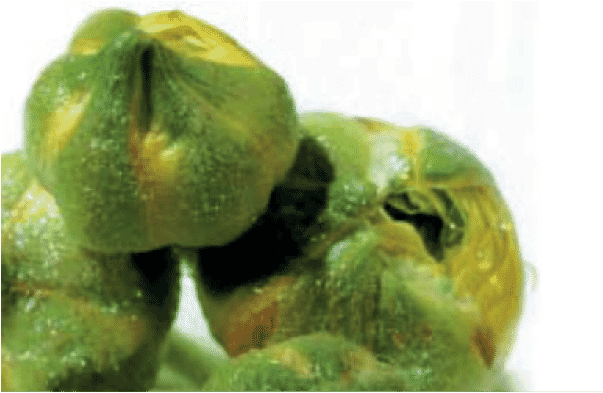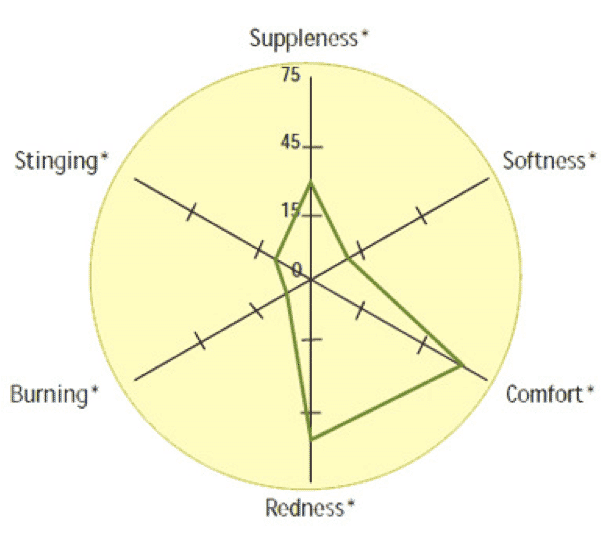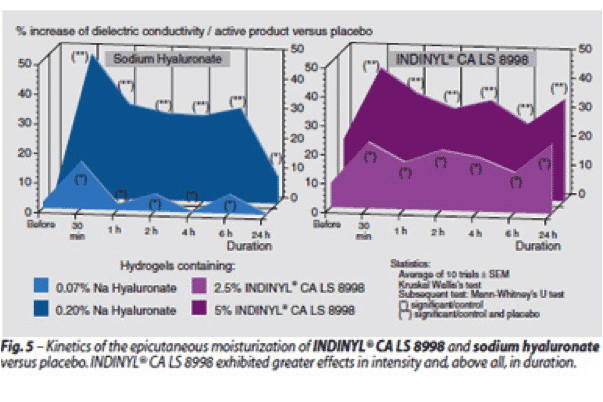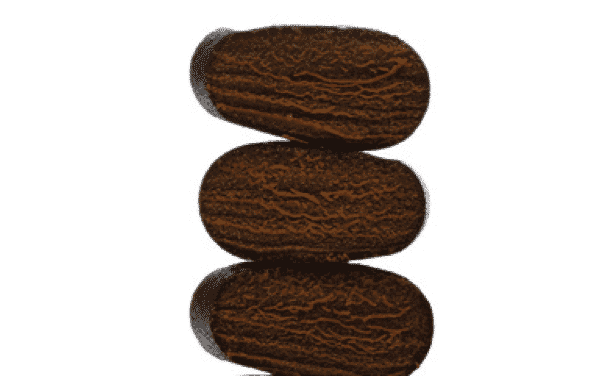Research on the Active ingredients used in the KALME range


KALME uses a patented plant extract from freshly picked Caper Buds called Derma Sensitive.
An earlier study ¹ showed that the caper buds offer significant anti-inflammatory activity and are almost as effective as a pharmacologically recognised anti-inflammatory oxyphenbutazone. Capers induced a 50% reduction in inflammation, as opposed to 66% for the pharmaceutical reference.
The most active components of capers were then isolated ² and fortified by using a specialised extraction technique.
This fortified caper extract was then tested on In Vivo on a panel of 20 people with sensitive, reactive skin, prone to discomfort and redness. The product was applied to one side of the face, twice a day for 28 days. A cream containing a reference calming active, Bisabolol at 0.5%, was applied using the same protocol to the other side of the face.

KALME ACTIVE INGREDIENTS
After 4 weeks dermatologists found that Derma Sensitive treated skin had seen a significant improvement, of between 10 and 70%.
In particular, the researchers found redness had greatly reduced by 70% after the treatment.
- Ageel A.M. et al. Anti-inflammatory activity of some Saudi Arabian medicinal plants. Agents and Actions. 17(3-4), 1985: 383-384.
- Al-Said M.S. et al. Isolation and identification of an anti-inflammatory principle from Capparis spinosa. Pharmazie. 43(9), 1988: 640-641.
Indinyl
KALME incorporates an ingredient called INDINYL® which is an extract of an exotic Indian plant, to provide 24 hour moisturisation.
Acne is a common symptom of rosacea. Unlike normal acne which is often connected to greasy skin rosacea is a dry skin condition and effective moisturisation is vital for Rosacea sufferers.
INDINYL is a natural vegetable based version of hyaluronic acid which is one of the main building blocks of the skin and is vital for healthy skin function.

Kalme Active Ingredients
In trials French researchers from Laloratoires Sérobiologiques who developed INDINYL found that it had an immediate and prolonged moisturizing effect over 24 hours on superficial epidermal layers. The extract improved the long-term moisturisation of the skin by improving the capacity of the stratum corneum to retain onto water.
SUPPORTING INGREDIENTS
NDGA a super antioxidant.
NDGA is a powerful antioxidant 10-100 times more effective than vitamin E, vitamin C, or grape seed polyphenols (1). It is also more stable and more effective than green tea polyphenols.
NDGA helps to protect sun sensitive skin from the effects of UV and has strong anti-inflammatory effects through its antioxidant properties. It blocks UV effect on the skin and reduces the damage caused by UVB on skin by blocking UV-induced gene expression (9, 10). Further research found that it blocks the UV induced enzymatic breakdown of the support matrix in the skin which results in fine lines and wrinkles (premature aging). (11)

These properties are especially useful for rosacea sufferers as inherent sun sensitivity is a hallmark of the disease. The photoprotective properties of NDGA help lessen reactivity to ultraviolet light, thereby reducing the signs and symptoms of rosacea. Moreover, NDGA has been shown to reduce the disruption of the skin barrier often seen in patients with rosacea. NDGA may also directly improve the signs of rosacea by reducing the number and appearance of telangiectasias (Thread veins).
Finally, NDGA inhibits the synthesis of inflammatory mediators such as prostaglandins and leukotrines (2, 3). It prevents leukocyte infiltration into tissues and release of reactive oxygen species (4-6). It also blocks chemically induced skin irritation (7, 8).
References:
2. Opthalmic Res., 1997, 29: 227-36
3. Biol Pharm Bull., 2000, 23: 47-53
4. Scand J. Immunol., 1996, 43: 127-33
5. Biochem Pharmacol., 1993: 45: 783-86
6. J. Vet Pharmacol. Ther., 1990: 13: 186-91
7. Arch Dermatol. Res., 1991, 283: 262-8
8. Pharmazie 1995, 50: 156-7
9. Mol. Carcinog., 2002: 34: 102-11
10. Phtochem. Phtobiol., 2003: 78: 68-74
11. Exp Cell Res., 2003: 288: 208-17
Liquorice Extract containing high levels of Glycyrrhizic acid.

KALME also contains Glycyrrhizin, an extract of liquorice which has been found in laboratory studies to reduce inflammation, promote mucous secretion, soothe irritation, and stimulate adrenal gland activity. (4) Glycyrrhizin also has antiviral properties, combating hepatitis B, influenza, and HIV by boosting T-cell counts and stimulating production of interferon and other protective compounds. (5)
A study by Yokota and associates reported that glabridin, an element in KALME’s liquorice extract, inhibited UVB-induced pigmentation and erythema. (6) The compound's anti-inflammatory properties are due to the inhibition of superoxide anion production and cyclooxygenase activity.
Glycyrrhizinic acid has also been shown to improve dermatitis. In a study by Saeedi and associates, 2% glycyrrhizinic acid gel was reported to significantly decrease scores for erythema, edema, and itching over the 2-week treatment period. (7)
[4]. University of Maryland Medical Center. Accessed November 7, 2005.
[5.] PDR for herbal medicines. Montvale (NJ): Thompson Medical Economics; 2000. Ginseng: 346-51.
[6.] Yokota T, Nishio H, Kubota Y, Mizoguchi M. The inhibitory effect of glabridin from licorice extracts on melanogenesis and inflammation. Pigment Cell Res. 1998;11:355-61.
[7.] Saeedi M, Morteza-Semnani K, Ghoreishi MR. The treatment of atopic dermatitis with licorice gel. J Dermatolog Treat. 2003;14:1537.
Perilla Frutescens extract (Also known as Shiso Oil)
KALME contains an extract of Perilla oil which is derived from the seed of the plant Perilla frutescens. It is a very rich source of alpha-linolenic acid - about 50 to 60% of perilla oil is alpha-linolenic acid. Alpha-linolenic acid is an omega-3 fatty acid which is highly beneifical to skin and has anti-inflammatory, antioxidant, antimicrobrial and anti fungal effects when applied topically [1] [2]
[1] Biosci Biotechnol Biochem. 2002 Apr;66(4):921-4.
[2]Zhongguo Zhong Yao Za Zhi. 1990 Feb;15(2):95-7, 126-7.

